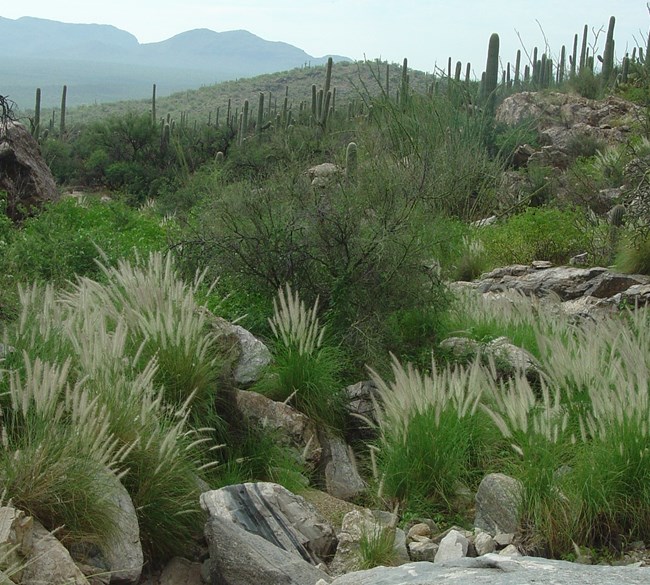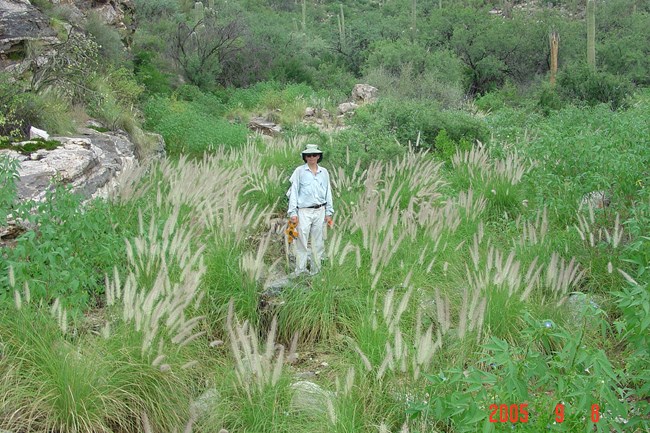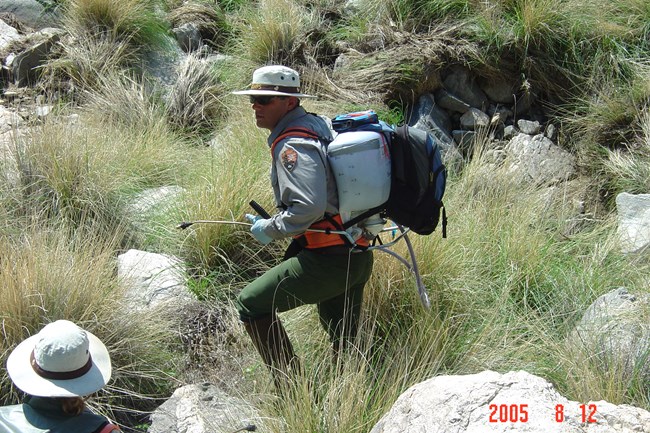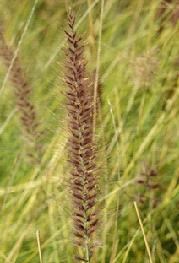
NPS Staff Invasive Plant Species: Fountain GrassFountain grass (Pennisetum setaceum), is a perennial bunch grass with attractive purple or green flowers. It is an ornamental plant that is still sold in nurseries. Although some nursery varieties are considered "sterile", no varieties are recommended for planting and landscaping. Choose other attractive native grass alternatives for your landscape, like sacaton (Sporobolus wrightii), or rabbit-resistant deer grass (Muhlenbergia regens).
Fountain grass is a close relative of buffelgrass, the most problematic invasive species in Saguaro National Park. Fountain grass is present in much of the western United States and is a big problem invasive species in Arizona, Nevada, Hawaii, and California. It is regulated as a noxious weed only in Hawaii, where it alters the fire cycle to the detriment of native plant and animal species. How Did It Get Here?Fountain grass is a native of Africa. Fountain grass seed was first available in the US around 1880 and has been cultivated as an ornamental plant in Tucson since 1940. Records document that fountain grass began establishing itself in the Santa Catalina Mountains north of Tucson as early as 1946. Fountain grass is sold in nurseries for gardens and landscapes. The seeds are carried by wind, water and on animals and humans. Seeds can remain viable in the soil for at least six years. 
NPS Staff What is the Threat?Fountain grass can form dense stands with several undesirable effects. It provides a large amount of fuel for hot fires that can destroy native plants and animals. It displaces native grasses, blocks the natural flow of water in washes, and alters the habitat for animals, particularly frogs and toads that are sensitive to such changes. Fountain grass occurs mainly in the washes in the Park, but has also been found on steep slopes. It grows rapidly on hillsides, along roadsides, and in washes all around Tucson. 
NPS Staff Management Goals and StrategiesOur goal is to manage fountain grass to prevent fire, to protect sensitive habitat, and to maintain free-flowing water. We use manual and chemical controls. We remove it manually by pulling, being careful to get the roots, from which it can re-sprout. Rock hammers are often required to break the roots free from among the rocks. We treat it chemically by spraying an aquatic approved herbicide. Spraying is more efficient, but is only effective when the plants are green. Pulling is effective year-round. Progress to DateFountain grass is an ongoing concern. It is monitored and manually removed through our Weed Free Trails program. Chemical controls are used in current areas that are undergoing treatment for buffelgrass & other invasive plants. 
TNC.org How to Identify Fountain GrassFountain grass grows in dense clumps 2 to 3 feet tall. Attractive pink or purple bottle brush flowers are seen on green plants. The bunchy plant and bristly seed heads both turn a light tan color when dry. Although it is a close relative of buffelgrass, it has a much neater appearance. The individual grass blades are straighter, less branched, and not as scraggly. How You Can HelpDon't plant fountain grass and if you have it in your yard, please remove it. If it grows in your neighborhood, enlist the help of your neighbors. Organize a neighborhood Saturday clean-up event. If you see fountain grass for sale at a local nursery, speak to the manager about your concern. Nurseries may offer "sterile" plants, which are not really sterile, they are just unsuitable for deliberate propagation; these plants still produce a small percentage of viable seeds that can escape and harm our desert. If you see fountain grass in the park, tell us, but don't pull it. If you have a camera and/or GPS, take a picture and record the coordinates (UTM coordinates are preferred). E-mail your information to sagu_invasive@nps.gov. More InformationMore information about fountain grass, what it looks like and the impact it is having on local and distant ecosystems, can be found on these websites. Arizona Native Plant Society Native plant alternatives to Fountain Grass Cabeza Prieta Wildlife Refuge Fountain Grass information California Invasive Plant Council Fountain Grass in California |
Last updated: May 6, 2025
